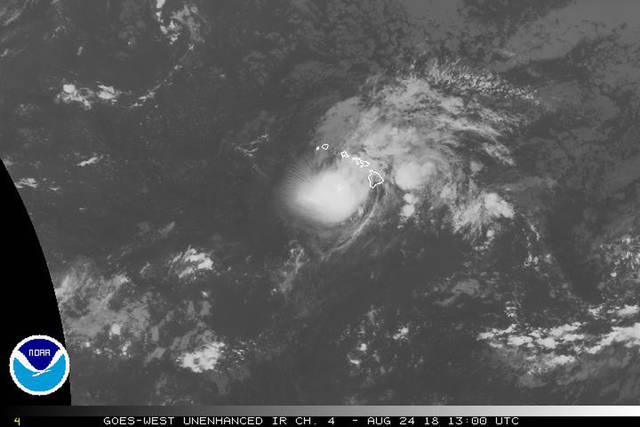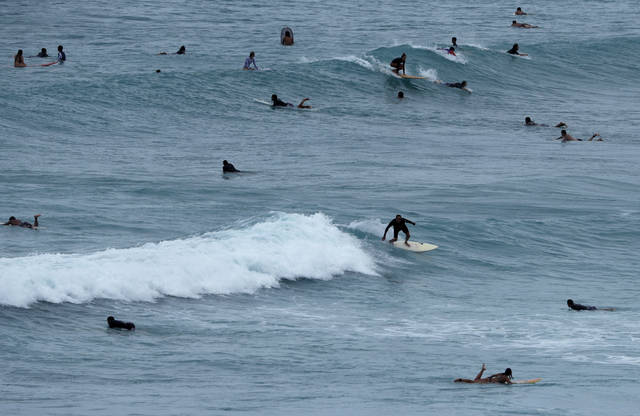HONOLULU — Many of the safety concerns from Hurricane Lane focused on high surf and storm surge, said National Weather Service meteorologist Chevy Chevalier
“We’re expecting surf in the 15- to 20-foot range on the southern shores of these islands,” he said. When heavy rain falls on steep mountains, “that water comes down fast. So it comes down and joins the water that’s coming up on the southern shores and what does that do? If floods the coastal areas.”
Police warned tourists to leave the world-famous Waikiki Beach ahead of the storm’s arrival in Honolulu. So far, about 1,500 people, mostly on Oahu, were in emergency shelters, said Brad Kieserman of the American Red Cross.
Emergency crews rescued five California tourists from a home they were renting in Hilo after a nearby gulch overflowed and flooded the house on the Big Island.
Suzanne Demerais said a tiny waterfall and small stream were flowing near the home when she first arrived with four friends from the Los Angeles area. But the stream turned into a torrent, and the river rose rapidly over 24 hours.
Hawaii County firefighters, who were in touch with the home’s owner, decided to evacuate the group before the water rose any higher. They floated the five out on their backs, Demerais said.
“It was quite an experience because we weren’t planning to have a hurricane during our vacation time,” Demerais said.
Elsewhere, a brushfire forced the relocation of a hurricane shelter in Lahaina on the island of Maui. Nearby residents were also being evacuated. A Maui County spokesman said it’s was not clear if the fire was hurricane related.
Hurricane Lane lashed the Big Island with more than 30 inches (76 centimeters) of rain in about 24 hours. A wind gust of 67 mph (107 kph) was recorded at Kohala Ranch on the northern side of the island.
About 200 miles (320 kilometers) north of Hilo, on the state’s most populated island of Oahu, employees of the Sheraton Waikiki resort filled sandbags to protect the oceanfront hotel from surging surf.
Stores along Waikiki’s glitzy Kalakaua Avenue stacked sandbags along the bottom of their glass windows to prepare for flash flooding.
Police on loudspeakers told surfers and swimmers to get out of the water, saying the beach would be closed until further notice.
The Marriott Resort Waikiki Beach in Honolulu designated a ballroom on the third floor as a shelter for guests and began removing lounge chairs from around the pool and bar area.
At the Hilton Hawaiian Village, guest Elisabeth Brinson said hotel staff left a notice that rooms will still have water and phone service, and a backup generator would power one elevator per building in the event of an electrical outage.
Brinson, a native of the United Kingdom now living in Denver, said many shops were closed, and those still open were frantic with people buying food, beer and water to take back to their rooms.
“We knew it was coming, so I tried to just cram as much as I could into the last few days in anticipation so we could cross things off of our list,” said Brinson, who is used to hurricanes after living in Florida.
United Airlines canceled its Friday flights to and from Maui. The airline added two more flights from Honolulu to San Francisco on Thursday to help transport people off the islands.
Hawaiian Airlines canceled all Friday flights by its commuter carrier, Ohana by Hawaiian.
The biggest hotels were confident they could keep their guests safe as long as they stay inside, said Mufi Hannemann, CEO of Hawaii Tourism and Lodging Association.
“The only concern is those that venture outside of the properties, that would like to hike on a day like this or who would like to still go into the ocean and see what it’s like to take a swim or surf in these kind of waters,” Hannemann said.
The central Pacific gets fewer hurricanes than other regions, with about only four or five named storms a year. Hawaii rarely gets hit. The last major storm to hit was Iniki in 1992. Others have come close in recent years.
Because people in Hawaii can’t evacuate during a hurricane like people in Florida or Texas, they have to make sure they have enough supplies to outlast power outages and other potential emergencies.
The Federal Emergency Management Agency moved several container ships packed with food, water, generators and other supplies into the region ahead of Hurricane Hector, which skirted past the islands more than a week ago, Long said. Warehouses were double-stocked with emergency supplies, and federal officials were working with grocers to ensure stores would have enough food.
———
Associated Press writers Brian Skoloff and Caleb Jones in Honolulu, Mark Thiessen and Dan Joling in Anchorage, Alaska, Colleen Long and Seth Borenstein in Washington and Annika Wolters in Phoenix contributed to this report.





